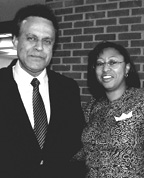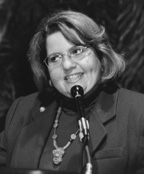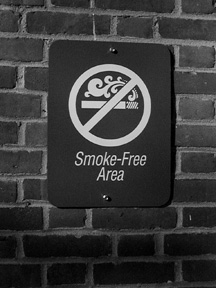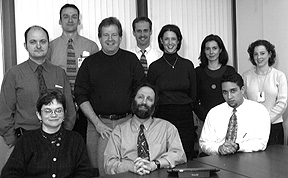| SEEKING DIVERSITY IN THE SCIENTIFIC RANKS | ||
 |
 |
 |
|
Joseph
Curtis
|
NICHD's
Hamid Khan and Dorothy McKelvin
|
Arlyn
Garcia-Perez
|
|
During
a panel discussion February 11 in Lipsett Auditorium on the importance
of diversity in the biomedical community, Joseph Curtis (left),
a former postdoc in the lab of NCI’s Ira Pastan, said that
African-Americans are "even less well represented outside academia"
than within it and therefore have a "chance to make a huge
impression." Now a Maryland-based independent consultant to
small companies seeking FDA approval for diagnostics, Curtis said
he is often the "first African-American [his clients in the
international biotechnology community] have ever seen." NICHD’s
Hamid Khan (center, left) cited two myths that block acceptance
of some women and minority scientists: that they are too "laid
back" or nonproductive and that they "can’t communicate"
because they have accents or speak softly. NHLBI senior investigator,
Arlyn
Garcia-Perez (right), who insisted she has "never spoken
softly," told the audience that "NIH is perceived as unfriendly"
to minority scientists. Making the community more diverse, she said,
would strengthen it. Garcia-Perez joined the Office of Intramural
Research, OD, this year as assistant director—C.H.
|
||
|
The Mitochondrion Research Society (MRS) has been formed to foster interdisciplinary collaborations to advance understanding of mitochondrial biology and the role of mitochondria in such areas as aging, cancer, toxicology, and neurobiology. MRS was founded by Steve Zullo, NIMH, coordinator of the Mitochondria Interest Group (MIG) at NIH and Keshav Singh of the Johns Hopkins Oncology Center (JHOC). Membership is currently free. To join, send your name, address, phone number, e-mail address, and research interests to: Cindy Morin, JHOC, 600 North Wolfe Street/Room No. 2-121, Baltimore, MD, 21287, U.S.A.; fax: 410-955-8780. Info can also be found at <http://wwwlecb.ncifcrf.gov/~zullo/migDB/MRS.html>. |
FARE 2000: MORE NIH FELLOWS TO REAP AWARDS IN MILLENNIAL COMPETITION The sixth annual NIH-wide Fellows Award for Research Excellence (FARE) 2000 competition will again provide recognition for the outstanding scientific research performed by intramural postdoctoral fellows. Winners of FARE awards will each receive a $1000 stipend to use for presenting their work at a meeting in the United States. Fellows who apply to FARE submit an abstract of their research; abstracts are then peer reviewed in a blinded study section. The award must be used between October 1, 1999, and September 30, 2000. The FARE 2000 competition is open to postdoctoral IRTAs, visiting fellows, and other fellows with less than 5 years total postdoctoral experience in the NIH intramural research program. Pre-IRTAs currently enrolled in a Ph.D. program may also compete. Visiting scientists and fellows must not have been tenured at their home institution. Questions about eligibility should be addressed to your institute’s scientific director. Fellows are asked to submit their application and abstract with an online application available from <ftp://helix.nih.gov/felcom/index.html>. Applications will be accepted from May 3–June 1, 1999 (12:00 noon E.S.T.). Winners will be announced by September 1999. Questions about FARE 2000 should be directed to <FARE2000@box-f.nih.gov> or to your institute’s Fellows Committee representative. Information is also available on the Fellows Committee site. FARE 2000 is sponsored by the NIH Fellows Committee, the scientific directors, the NIH Office of Research on Women’s Health, and the NIH Office of Education. The FARE 2000 award is funded by the scientific directors and the NIH Office of Research on Women’s Health. Last year’s
FARE 1999 was very successful; 666 abstracts were submitted, and
130, or 19.5 percent, were funded. The FARE 2000 competition will
provide an even higher level of funding—25 percent of applicants
will receive a $1000 award. Through the month of June, sets of related
winning FARE 1999 posters are being displayed outside the Visitor’s
Information Center in Building 10 on Wednesday afternoons, in conjunction
with the Wednesday Afternoon Lecture series.
|
||
| NEW
ANTIBODY PURIFICATION METHOD NHLBI investigators have developed a new protein-purification method—centrifugal precipitation chromatography—that uses ammonium sulfate and potassium phosphate buffer only (no solid support). They have used the method to purify and concentrate monoclonal antibodies—immunoglobin M (IgM)—against mast cells and think it may be equally successful in purifying either IgM or IgG from a culture medium or an ascitic fluid. Because they
are quite interested in testing the capability of the method in
purifying antibodies and other proteins, the NHLBI researchers are
putting themselves at the service of other intramural researchers
with problems purifying antibodies. Anyone with such a problem should
contact Yoichiro
Ito, who can be found in Building 10, Room 7N322, and can also
be reached by phone at 496-1210 and by fax at 402-3404. |
|||
|
|||
 |
The signs are now posted all over campus: "Smoke-Free Area" signs extend to certain outdoor areas what has been a standing prohibition against using lighted tobacco products inside NIH buildings. These outdoor areas include all building entrances and exits, air-intake ducts, loading docks, covered parking garages, and designated courtyards. The prohibition is in accordance with an executive order issued in 1997 mandating that all federal agencies protect employees and visitors from the health risks of environmental tobacco smoke. An updated NIH Smoking Policy, crafted by an NIH committee composed of smoking and nonsmoking employees and signed by NIH Director Harold Varmus last May, can be found on the web. The policy applies to all NIH employees, other federal employees, and members of the public who are working in or visiting facilities owned, leased, or controlled by NIH. Further, NIH strongly encourages and
supports employees who want to break the smoking habit. Anyone interested
in smoking cessation programs may contact the NIH Employee Assistance
Program at (301) 496-3164. |
|
Small laboratory animals used by NIH intramural scientists will soon be able to be purchased online. Thanks to the combined efforts of the Veterinary Resources Program (VRP), CIT, and NIMH—and numerous consultants from NIH Intramural Animal Programs—VRP is piloting the Central Animal Procurement System, or CAPS. CAPS will replace the current cumbersome paper process and be accessible via PCs or DELPRO terminals. Linked to the ADB and Central Accounting System, it will automatically bill ICs and generate data to enable prompt payment of vendors. The system has been designed with built-in levels of authority for investigators, IC (animal-procurement) approving officials, animal facility managers, IC animal facility receiving technicians, animal-program directors, VRP animal-procurement staff, the Office of Financial Management/Accounts Payable, and the NHLBI Contracts Operations Branch Servicing Center. As soon as the kinks are worked out in the pilot—with NIMH—the remaining NIH animal programs will be brought online. It’s anticipated that CAPS will be fully operational in late spring or early summer 1999. |
